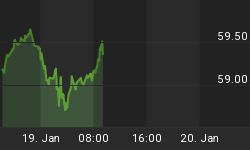In case nobody is watching, the 30 Year Bond Yield is about to test its 8 year resistance for the second time. This is something to keep a close eye on, because 30 year yields and mortgage rates go hand in hand. See the long term chart below.
The concern is that home building is in a slump and many are speculating that we might be at a bottom ... ready to turn around. If the 30 year yield jumps up, then that would effect how large a home someone could afford, and it would mean that home sellers would get less for their homes in the longer term ... and fewer homes would sell.
For instance, the average new 30 year fixed mortgage is now 6.05%. At 6%, a $300,000 mortgage is $1710 per month. At 7%, the mortgage goes up to $1916 for an increase of 12%. That means that a borrower would have to pay the same $1710 now for a house that was $264,000. He either gets the $300,000 on sale for $264,000 or he buys a cheaper house. That creates a competitive situation for home sellers where they would have to lower the price of their home in order to hook one of the fewer buyers that are out there.
The point is, if we see the TYX break out of its resistance and move higher, it will significantly hurt the housing industry that is already in a lot of trouble.
If mortgage rates escalate, then the Fed is going to have a bigger problem to fix. Sub-prime and variable rate mortgages will rise dramatically with a substantial increase in foreclosures. The level of consumer home buying will decrease with the effect of lowering the value of homes. This could make banks nervous as the spread between equity vs. mortgage debt reduces the protection cushion that banks want to have.
The 30 year yield hasn't broken above its long term resistance, but is certainly something that investors should keep an eye on because of the possible long term implications.

The housing sector is still in deep trouble in spite of Bill Gates and Warren Buffett buying housing stocks weeks ago in the belief that the sector would be bottoming out and improving.
However, the carnage in home building has not stopped. Home builder, Meyer-Sutton, filed for bankruptcy on Monday saying that, "The housing market has suffered a dramatic decline in demand, with the result problems of excess inventory and compressed profit margins,". In its bankruptcy filing, the company stated that it has cut new construction starts to 2 per month from 25 per month ... a 92 % decrease in the number of homes they were building.
Ara Hovnanian predicted that housing sales will not rebound significantly this year. Hovnanian Enterprises Inc., reported a quarterly loss of $30.7 million last Thursday.
Toll Brothers reported lower earnings, and Pulte Homes announced that it is slashing 1,900 jobs, or about 1 in 6 of their employees.
Below is the Residential Sector Monthly chart going back to 2002. Clearly, the sector is still "under water".

















